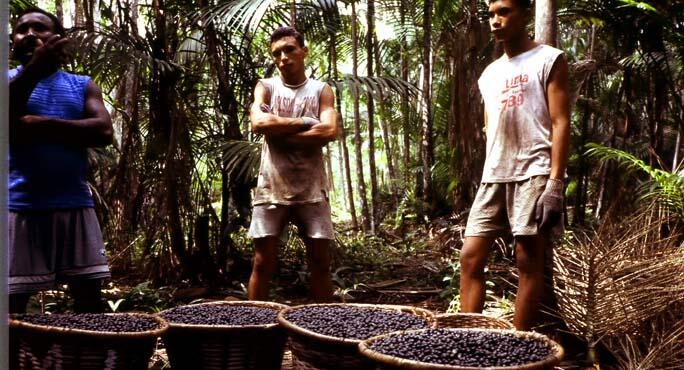Common Name
Botanical Name
The first time I ever tried acai, the fruit was served to me in 1997 as a drink by an Ipixuna Indian woman, when I was living on the Amazon river for a month. Acai, Euterpe oleracea, was as deep purple as any food I had ever seen. In fact, a spill stained a favorite t-shirt of mine forever. I loved the rich flavor of acai, and the energy it imparted, and consumed as much as I could during the course of my time on the river.
Fast-forward to October 2003, once more in the Brazilian rainforest, this time in the company of Ryan Black, founder of Sambazon Acai. We are watching several hard-working Brazilians climb tall acai palms rapidly, cut branches laden with ripe purple acai berries, and strip the berries into baskets, readying them for processing. “Our wildharvesting system was developed in conjunction with the Forest Sustainability Council,” Ryan explains. “We’ve taught people how to wildharvest acai, and protect the forest at the same time.”
Ryan, a former Minnesota Vikings football player, would never describe himself as a hero. And you certainly could not call him one just because he has taken a previously unknown Amazonian fruit, obtained organic certification, put it pureed into freezer paks, and secured distribution throughout the United States in natural foods stores, juice bars and cafes. Nor could you call him a hero because he has put Sambazon Acai onto training tables all over the country, and has won the ardent support of surfers, volley ball players, and athletes of all stripes. But you certainly could legitimately claim that Ryan and his associates are doing heroic work. Through ecologically sound agro-forestry management practices, Sambazon has established a top-notch conservation program that protects the Amazon rainforest and minimizes habitat loss. On top of that, they’ve implemented a fair wage system that provides higher than average wages to over eight thousand people in Brazil’s Para state. Sambazon has won praise and support from World Wildlife Federation, The Nature Conservancy and Greenpeace. As far as Ryan Black is concerned, it’s all just a reasonable and fair way to operate a business. “Might as well do it right if you’re going to do it,” he comments.
Even without the practices that make Sambazon Acai a highly praised model of sustainable business, the fruit itself is a hands-down winner. Acai is a staple food throughout Amazonia, and that status owes directly to its marvelous flavor. Acai explodes with flavor, and gets better with every mouthful. Rich in the potent purple pigments called anthocyanins, acai has a higher antioxidant activity rating than bilberries or blueberries, and is rich in beneficial dietary fibers. A glass of blended acai fruit, with just a slight touch of guarana and certified organic sugar, imparts so much energy, you’ll want to dance and yodel while climbing a mountain at the same time. No wonder endurance cyclists and ball players have taken to this fruit. Sambazon Acai has attracted a following the old-fashioned way, through intensive sampling. “Once people try the product,” says Ryan “they want it.”
Harvested from August through December in the hot, humid Amazon rainforest, acai is a high labor fruit. I watch the remarkable climbing skills of the harvesters, and realize with some sadness that I could never climb trees like that, let alone do it every day. Ryan nudges me. “These guys are amazing, aren’t they?”
We are invited into a large wooden house with open windows and about a dozen children crowding around us, to watch a woman prepare acai the traditional way. Sambazon Acai is prepared in a state of the art manufacturing facility in sterile stainless steel equipment. But in this house, the preparation is all performed by hand. The woman hand grinds the berries through fiber mats, until the juice and fine pulp drip into a container underneath. After laboring on our behalf for more than half an hour, she serves us acai. Several of us spoon the rich berry preparation into our mouths, and laugh at our good fortune until tears form in our eyes. “Now this is how to eat acai,” Ryan declares. For the majority of American consumers, Sambazon freezer packs will get them closest to the Amazonian acai experience.
Over the coming years, we will hear a lot about sustainability. The term will emerge as the hot buzzword, like the term organic in the early 1980’s. We’ll see the sustainable label used by organic growers and petroleum companies alike. Mark my words, thousands of companies will scramble to label themselves “sustainable.” Yet very few will accomplish what Sambazon Acai has set in motion. For the flavor of the berry or the cause behind their product, they are way out in front.
By Chris Kilham, for Natural Food Merchandiser


